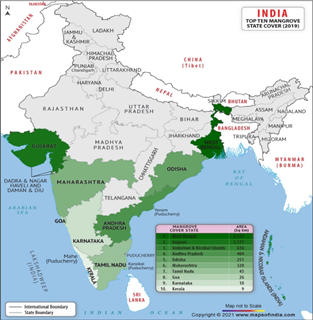Mangroves and its significance in Climate change:
- Posted By
10Pointer
- Categories
Environment
- Published
27th Jul, 2022
-
-
Context
Mangrove trees are well-equipped to combat climate change, according to a recent study.
-
What are mangroves?
- Mangroves are a diverse group of salt-tolerant plant communities in tropical and subtropical regions of the world that can survive the limiting factors of lack of oxygen, high salinity, and daily tides.
- Mangroves are a group of trees and shrubs that live in the coastal intertidal zone.
- They are included in Type Group-4 Littoral & Swamp Forests.
- Mangroves are flowering trees belonging to the families Rhizophoraceae, Acanthaceae, Lythraceae, Combretaceae and Arecaceae.

-
What are the special features of the mangroves?
- Survival in saline environment: They can survive in extreme hostile environments such as high salt and low oxygen conditions.
- Low oxygen content: The underground tissue of every plant needs oxygen for respiration. But in a mangrove environment, there is limited or no oxygen in the soil.
- Therefore, the root system of mangroves absorbs oxygen from the atmosphere.
- Mangroves have special roots called respiratory roots or pneumatophores for this purpose.
- These roots have numerous pores through which oxygen reaches the underground tissues.
- Surviving Extreme Conditions: With roots submerged in water, mangrove trees thrive in hot, muddy and salty conditions that would quickly kill most plants.
- Succulent leaves: Mangroves, like desert plants, store fresh water in thick, succulent leaves.
- The wax coating on the leaves seals in water and minimizes evaporation.
- Viviparous: Their seeds germinate while still attached to the parent tree. Once the seedling germinates, it grows into a propagule.
- The mature propagule then falls into the water and is transported to another location where it eventually roots in solid ground.
- Foliar Water Uptake (FWU): A mechanism which help the mangroves to acquire water from atmosphere.
-
How mangroves are significant to the environment?
- Mangrove’s special roots, such as buttress roots, pneumatophores, help prevent water flow, thereby improve sediment deposition in areas (where they already occur), stabilize coastal banks, provide food for fish.
- Mangroves moderate monsoon tidal flooding and reduce flooding of coastal plains.
- They prevent coastal soil erosion and also protect coastal countries from tsunamis, hurricanes and floods.
- Mangroves increase the natural recycling of nutrients.
- The mangrove supports numerous flora, avifauna and wildlife.
- They provide a safe and favorable environment for reproduction, spawning and rearing of several fish.
- They supply wood, firewood, medicinal plants and edible plants to the local people.
- They provide numerous employment opportunities to local communities and enhance their livelihoods.
- Essential for climate change: The amazing ability of mangroves to take up water from rain and atmospheric water, makes it a better candidate to answer climate change problems.
-
Geographical distribution of mangroves:
Global Distribution:
- According to the Global Forest Resource Assessment 2020 (FRA 2020), 113 countries worldwide have mangrove forests covering an estimated 14.79 million hectares.
- Asia has the largest areas of mangroves, followed by Africa, North and Central America, and South America.
- Oceania has the least amount of mangroves.
- More than 40% of the total mangrove area is found in just four countries: Indonesia (19%), Brazil (9%), Nigeria (7%) and Mexico (6%).

Mangrove profile In India:
- Mangroves cover 4,992 sq km or 0.15% of India’s total area. Of this-
- 1,475 sq km has very dense mangrove
- 1,481 sq km, moderately dense mangrove
- 2,036 sq km, open mangroves
- The largest mangrove forest in India is the Sundarbans in the Ganges Delta. This mangrove is spread all over India and Bangladesh.
- The 2nd largest mangrove ecosystem in India is Bhitarkanika located on the Odisha coast.
- The Godavari-Krishna mangrove forests are located on the east coast of Andhra Pradesh.
- Pichavaram mangroves are in Tamil Nadu.
- Mangrove forests are also found near the city of Mumbai on the west coast.
- They are also found in the Andaman and Nicobar E.g. mangroves on Baratang Island.



